City in Kano State, Nigeria
| Kano | |
|---|---|
| City | |
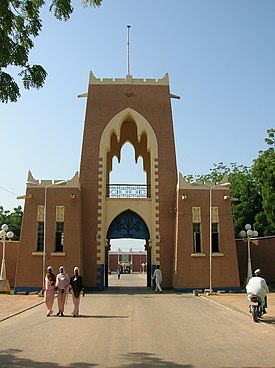  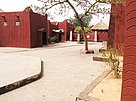   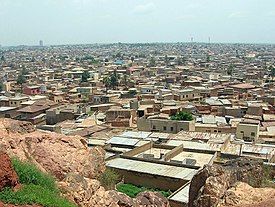 Left to right from top: Left to right from top:Gidan Rumfa/Emir's Palace, the Ancient Kano City Walls, courtyard of Gidan Makama, city neighborhood, traditional dyer at the Kofar Mata Dye Pits, and city skyline from Dala Hill | |
  | |
| Coordinates: 12°00′N 8°31′E / 12.000°N 8.517°E / 12.000; 8.517 | |
| Country | |
| State | Kano State |
| Government | |
| • Emir | Muhammadu Sanusi II |
| Area | |
| • City | 499 km (193 sq mi) |
| • Urban | 251 km (97 sq mi) |
| Elevation | 488 m (1,601 ft) |
| Population | |
| • City | 2,828,861 |
| • Estimate | 4,103,000 |
| • Rank | 2nd |
| • Density | 5,700/km (15,000/sq mi) |
| • Urban | 4,224,966 |
| • Metro | 4,645,320 |
| GDP (PPP, constant 2015 values) | |
| • Year | 2023 |
| • Total | $26.4 billion |
| • Per capita | $6,100 |
| Time zone | UTC+1 (WAT) |
| Climate | Aw |
Kano (Ajami: كَنُواْ) is a city in northern Nigeria and the capital of Kano State. It is the second largest city in Nigeria after Lagos, with over four million citizens living within 449 km (173 sq mi). Located in the savanna, south of the Sahel, Kano is a major route of the trans-Saharan trade, having been a trade and human settlement for millennia. It is the traditional state of the Dabo dynasty who have ruled as emirs over the city-state since the 19th century. Kano Emirate Council is the current traditional institution inside the city boundaries of Kano, and under the authority of the Government of Kano State.
The city is one of the seven medieval Hausa kingdoms. The principal inhabitants of the city are the Hausa and Fulani people. Centuries before British colonization, Kano was strongly cosmopolitan with settled populations of Arab, Tuareg, Kanuri and remains so with the Hausa language spoken as a lingua-franca by over 70 million speakers in the region.
Islam arrived in the city in the 11th century or earlier primarily through the trans-Saharan trade. As a result, Kano became wealthy and the commercial nerve centre of the region and Northern Nigeria, and is still associated as the "centre of commerce".
Etymology
Kano was originally known as Dala, after the hill, and was referred to as such until the end of the 15th century and the beginning of the 16th by Bornoan sources.
History
See also: Timeline of KanoFounding and Bagauda dynasty
See also: Kingdom of Kano and Bagauda Dynasty
In the 7th century, Dala Hill, a residual hill in Kano, was the site of a hunting and gathering community that engaged in iron work (Nok culture); it is unknown whether these were Hausa people or speakers of Niger–Congo languages. The Kano Chronicle identifies Barbushe, a warrior priest of Dala Hill and a female spirit deity known as Tsumburbura, Barbushe is from the lineage of the hunter family (maparauta) who were the Maguzawa and city's first settlers they worship the deity Tsumburbura (Elizabeth Isichei notes that the description of Barbushe is similar to those of Sao people).

While small chiefdoms were previously present in the area, according to the Kano Chronicle, Bagauda son of Bawo and grandson of the mythical hero Bayajidda, became the first king of Kano in 999, reigning until 1063. His grandson Gijimasu (1095–1134), the third king, began building city walls (badala/ganuwa) at the foot of Dala Hill. His own son, Tsaraki (1136–1194), the fifth king, completed them during his reign.
Middle Ages: spread of Islam and trade
See also: Sultanate of Kano, Muhammad Rumfa, and Trans-Saharan tradeIn the 12th century, Ali Yaji from Kudawa lineage as King of Kano renounced his allegiance to the cult of Tsumburbura, converted to Islam and proclaimed the Sultanate that was to last until its fall in the 19th century. The reign of Yaji ensued an era of expansionism that saw Kano becoming the capital of a pseudo Habe Empire.

In 1463, Muhammad Rumfa (reigned 1463–1499) ascended the throne. During his reign, political pressure from the rising Songhai Empire forced him to take Auwa, the daughter of Askiyah the Great as his wife. She was to later become the first female Madaki of Kano.
Rumfa was a rich and flamboyant king. Luxurious clothing and expensive ostrich feather shoes were common among government officials. The kakaki (a kind of trumpet) was also first used during his reign. His wealth is owed to Kano's commercial prosperity during this period. Kano arguably achieved the height of its reputation as an important trading center of the trans-Saharan trade in the Middle Ages during his reign. Leo Africanus's description of Kano is believed to be that of Rumfas era. He described the locals as "wealthy merchants and skilled craftsmen" and commended the cavalry of the Sultan's army. He also noted the abundance of rice, corn, cotton and citrus fruits.
Rumfa reformed the city, expanded the Sahelian Gidan Rumfa (Emir's Palace), and played a role in the further Islamization of the city, as he urged prominent residents to convert and invited many prominent scholars to the city. He also built the walls of the city and the Kurmi market. The Kano Chronicle attributes a total of twelve "innovations" to Rumfa. According to the Kano Chronicle, the thirty-seventh Sarkin Kano (King of Kano) was Mohammed Sharef (1703–1731). His successor, Kumbari dan Sharefa (1731–1743), engaged in major battles with Sokoto as a longterm rivalry.
Fulani rule
See also: Kano EmirateAt the beginning of the 19th century, Fulani Islamic leader Usman dan Fodio led a jihad affecting much of central Sudan which demolished the Habe kingdom, leading to the emergence of the Sokoto Caliphate. In 1805 the last sultan of Kano was defeated by the Jobe Clan of the Fulani, and Kano became an Emirate of the Caliphate. Kano was already the largest and most prosperous province of the empire.
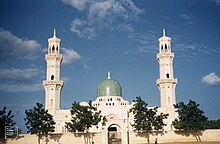
The city suffered famines from 1807 to 1810, in the 1830s, 1847, 1855, 1863, 1873, 1884, and from 1889 until 1890.
During the 19th century when Kano came under the suzerainty of the Sokoto Caliphate, Kano prospered as the center of commercial activity. Weaving, dyeing and leatherwork were traded as far north as Morocco and thereafter to Europe. Its cotton cloth traded as far as Tripoli, Lake Chad, and Timbuktu.
In 1851, Heinrich Barth (a German scholar who spent several years in northern Nigeria in the 1850s) mentioned that Kano had a 10-mile long 30 ft high clay walls with a population of 30,000 with commerce and manufacturing abundant. He mentioned "its huge market was a labyrinth of narrow alleys with everything sold from vegetables to slaves". He also called Kano the greatest emporium of central Africa and estimated the percentage of slaves in Kano to be at least 50%, most of whom lived in slave villages. This was one of the last major slave societies, with high percentages of enslaved population long after the Atlantic slave trade had been cut off.
From 1893 until 1895, two rival claimants for the throne fought a civil war, or Basasa. With the help of royal slaves, Yusufu was victorious over his brother Tukur and claimed the title of emir.
British colony, indirect rule, and independence

In March 1903, the city-state was absorbed into the British Empire after the Battle of Kano, the Fort of Kano was captured by the British, It quickly replaced Lokoja as the administrative centre of Northern Nigeria. It was replaced as the centre of government by Zungeru and later Kaduna, and only regained administrative significance with the creation of Kano State following Nigerian independence.

From 1913 to 1914, as the peanut business was expanding, Kano suffered a major drought, which caused a famine. Other famines during British rule occurred in 1908, 1920, 1927, 1943, 1951, 1956, and 1958. By 1922, groundnut trader Alhassan Dantata had become the richest businessman in the Kano Emirate, surpassing fellow merchants Umaru Sharubutu Koki and Maikano Agogo.
In May 1953, an inter-ethnic riot arose due to southern newspapers misreporting on the nature of a disagreement between northern and southern politicians in the House of Representatives. Thousands of Nigerians of southern origin died as a result a politically sparked riot.

Ado Bayero became emir of Kano in 1963. Kano state was created in 1967 from the then Northern Nigeria by the Federal military government. The first military police commissioner, Audu Bako, is credited with building a solid foundation for the progress of a modern society. He started a lot of development projects—network of roads, a reliable urban water supply. He was a keen farmer himself and funded construction of number of dams to provide irrigation. Thanks to his policies, Kano produced all types of produce and export it to the neighbouring states. The first civilian governor was Abubakar Rimi.
In December 1980, radical preacher Mohammed Marwa Maitatsine led a riot. He was killed by security forces, but his followers later started uprisings in other northern cities.
21st century
After the introduction of sharia law in Kano State in the early 2000s, many Christians left the city. 100 people were killed in riots over the sharia issue during October 2001.
In November 2007, political violence broke out in the city after the People's Democratic Party (PDP) accused the All Nigeria Peoples Party (ANPP) of rigging the November 17 local government elections. (The ANPP won in 36 of the state's 44 local Government Areas.) Hundreds of youths took to the streets, over 300 of whom were arrested; at least 25 people were killed. Buildings set on fire include a sharia police station, an Islamic centre, and a council secretariat. 280 federal soldiers were deployed around the city.

In January 2012, a series of bomb attacks killed up to 162 people. Four police stations, the State Security Service headquarters, passport offices and immigration centres were attacked. Jihadist insurgents Boko Haram claimed responsibility. After the bombings, Kano was placed under curfew. The Boko Haram insurgency continued with mass murders in March 2013, November 2014 and February 2015.
On 6 June 2014, Emir Ado Bayero who reigned as Emir of Kano for over five decades died, and a succession crisis loomed amongst the royal family. On 8 June 2014, Sanusi Lamido Sanusi a grandson of former Emir Muhammadu Sanusi I emerged as the new Emir of Kano. His accession led to widespread protests from supporters of Sanusi Ado Bayero the Chiroman Kano (Crown Prince) and son of the late Emir Ado Bayero, with allegations that Governor Rabiu Kwankwaso interfered with the king-making process.
In 2019, Governor Abdullahi Umar Ganduje balkanized the traditional Kano Emirate into four new emirates; Bichi, Rano, Gaya and Karaye. This unprecedented move was criticized by elders. According to the law, out of the 44 local government areas in the state, Sanusi as Emir of Kano will preside over just 10 local government areas; with the remainder carved up amongst the new emirates. On 9 March 2020, Sanusi was dethroned by Governor Abdullahi Ganduje. The emir was immediately moved to detention under heavy security escort to an apartment in awe, Nasarawa state. It took the intervention of the federal high court in Abuja to order his release from detention in Nasarawa.
Geography
Location
The city lies south of the Sahara Desert in the Sudanian Savanna region that stretches across the south of the Sahel. The city lies near where the Kano and Challawa rivers flowing from the southwest converge to form the Hadejia River, which eventually flows into Lake Chad to the east.
Climate
Kano is 481 metres (1,578 feet) above sea level. Kano has a tropical savanna climate (Köppen Aw). The city has on average about 980 mm (38.6 in) of precipitation per year, the large majority of which falls from June through September. Like the vast majority of Nigeria, Kano is very hot for most of the year, peaking in April. From December through February, the city is less hot, with morning temperatures during the months of December, January and February averaging between 14 and 16 °C (57.2 and 60.8 °F).
| Climate data for Kano (1991–2020) | |||||||||||||
|---|---|---|---|---|---|---|---|---|---|---|---|---|---|
| Month | Jan | Feb | Mar | Apr | May | Jun | Jul | Aug | Sep | Oct | Nov | Dec | Year |
| Record high °C (°F) | 39.0 (102.2) |
41.0 (105.8) |
42.4 (108.3) |
44.0 (111.2) |
44.8 (112.6) |
41.6 (106.9) |
38.5 (101.3) |
34.2 (93.6) |
39.0 (102.2) |
39.0 (102.2) |
39.0 (102.2) |
37.3 (99.1) |
44.8 (112.6) |
| Mean daily maximum °C (°F) | 29.4 (84.9) |
33.1 (91.6) |
37.0 (98.6) |
39.5 (103.1) |
38.2 (100.8) |
34.8 (94.6) |
31.7 (89.1) |
30.3 (86.5) |
32.1 (89.8) |
34.5 (94.1) |
33.7 (92.7) |
30.3 (86.5) |
33.7 (92.7) |
| Daily mean °C (°F) | 21.3 (70.3) |
24.7 (76.5) |
28.8 (83.8) |
32.0 (89.6) |
31.8 (89.2) |
29.2 (84.6) |
26.9 (80.4) |
25.9 (78.6) |
27.1 (80.8) |
27.7 (81.9) |
25.0 (77.0) |
21.9 (71.4) |
26.9 (80.4) |
| Mean daily minimum °C (°F) | 13.2 (55.8) |
16.4 (61.5) |
20.5 (68.9) |
24.6 (76.3) |
25.4 (77.7) |
23.7 (74.7) |
22.2 (72.0) |
21.5 (70.7) |
22.0 (71.6) |
20.9 (69.6) |
16.3 (61.3) |
13.5 (56.3) |
20.0 (68.0) |
| Record low °C (°F) | 5.0 (41.0) |
8.0 (46.4) |
10.0 (50.0) |
12.5 (54.5) |
18.3 (64.9) |
14.1 (57.4) |
15.0 (59.0) |
14.5 (58.1) |
14.1 (57.4) |
13.0 (55.4) |
6.5 (43.7) |
4.9 (40.8) |
4.9 (40.8) |
| Average precipitation mm (inches) | 0.0 (0.0) |
0.0 (0.0) |
0.3 (0.01) |
14.0 (0.55) |
70.1 (2.76) |
160.4 (6.31) |
306.9 (12.08) |
400.4 (15.76) |
175.2 (6.90) |
21.8 (0.86) |
0.0 (0.0) |
0.0 (0.0) |
1,149.2 (45.24) |
| Average precipitation days (≥ 1 mm) | 0.0 | 0.0 | 0.1 | 0.8 | 4.0 | 7.7 | 11.4 | 14.2 | 8.4 | 1.6 | 0 | 0 | 48.2 |
| Average relative humidity (%) | 25.3 | 20.3 | 18.8 | 29.7 | 46.1 | 56.8 | 66.2 | 75.6 | 72.5 | 56.0 | 35.6 | 30.3 | 44.4 |
| Mean monthly sunshine hours | 245 | 232 | 239 | 234 | 264 | 261 | 229 | 220 | 240 | 267 | 264 | 260 | 2,955 |
| Mean daily sunshine hours | 8 | 8 | 8 | 8 | 9 | 9 | 7 | 7 | 8 | 9 | 9 | 8 | 8 |
| Source: NOAA (sunshine 1961–1990) | |||||||||||||
LGAs
Metropolitan Kano has eight local governments:
| Local Government Area | Area (in km) |
Population (2006 Census) |
Population (2022 estimate) |
|---|---|---|---|
| Dala | 13.90 | 418,759 | 688,700 |
| Fagge | 35.27 | 200,095 | 329,100 |
| Gwale | 36.09 | 357,827 | 588,500 |
| Kano Municipal | 14.90 | 371,243 | 610,600 |
| Kumbotso | 186.7 | 294,391 | 484,200 |
| Nasarawa | 48.72 | 317,614 | 980,900 |
| Tarauni | 23.16 | 221,844 | 364,900 |
| Ungogo | 214.5 | 365,737 | 601,500 |
| Metropolitan Kano | 573.24 | 2,828,861 | 4,648,400 |

Economy
The economic history of Kano dates back to the Middle Ages when the city served as the southernmost point of the famous trans-Sahara trade routes. Kano was well connected with many cities in North Africa and some cities in southern Europe. By 1851, the city of Kano produced 10 million pairs of sandals and 5 million tanned hides annually for export, with other products including textile materials, leather and grains. Kano was connected with trans-Atlantic trade in 1911 when a railway line reached Kano. Kano is a major centre for the production and export of agricultural products like hides, skins, peanuts, and cotton.
The city maintains its economy and business even in the 21st century, with it producing the richest man in Africa—Aliko Dangote—whose great-grandfather Alhassan Dantata was the richest West African in the mid 20th century. Over the years, inconsistent government policies and sporadic electricity supply hampered manufacturing and industry, so that Kano's economy relies primarily on trade, retail and services. There are plans to establish an information technology park in the city.
Culture
Equestrianism

Kano is traditionally an equestrian society and this is manifested during the annual Durbar festival to mark and celebrate the two annual Muslim festivals Eid al-Fitr (to mark the end of the Holy Month of Ramadan) and Eid al-Adha (to mark the Hajj Holy Pilgrimage). Kano Durbar Festival is the Nigeria's Most Spectacular Horseparade that marks a celebration of northern Nigeria's cultural treasure. The festival begins with skilled horsemen from the royal court and aristocrats being accompanied by musicians, artillerymen, and traditional circus in a procession of highly rich and colorful style through the city on the way to the emir's palace. Once assembled near the palace, the horsemen separate into their respective groups, each under the banner of district head (hakimai) or a titled nobleman from the emir's court (masarauta), take it in turns to charge toward the emir, pulling up just feet in front of the seated dignitaries to offer their respect and allegiance. During the festival, the emir makes a beautiful appearance in different colors dressed and adorned with the attire of a king.
For the first time in 200 years, the durban horse festival was cancelled in 2012 due to the bad health condition of the Emir of Kano. Some analysts suggested that the cancellation could also be attributed to the rising deadly Boko haram attacks in the northern part of Nigeria at that time.
Architecture
Kano's architecture over the years has seen wide variations, especially from the traditional architecture to modern architecture. The city is a leading axis of Sudano-Sahelian architecture, developing the local Tubali style which manifested in mosques, walls, common compounds, and gates.
The design exteriorization of building façades was and is still widely used in Kano architecture, with the city harboring several skilled artisans.
Landmarks
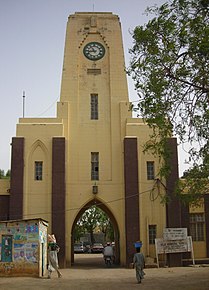
Old City
Formerly walled, most of the gates to the Old City survive. The Old City houses the vast Kurmi Market, known for its crafts, while old dye pits—still in use—lie nearby. In the Old City are the Emir's Palace, the Great Mosque, and the Gidan Makama Museum.
Places of worship
Among the places of worship, they are predominantly Muslims mosques.
There are also Christian churches for several denominations including :
- Church of Nigeria (Anglican Communion);
- Roman Catholic Diocese of Kano (Catholic Church);
- Nigerian Baptist Convention (Baptist World Alliance);
- Presbyterian Church of Nigeria (World Communion of Reformed Churches);
- Pentecostal megachurches including; Assemblies of God, Living Faith Church Worldwide; Redeemed Christian Church of God
Fortifications
See also: Ancient Kano City WallsThe Ancient Kano City Walls were built as a defensive wall with the construction of the foundation laid by Sarki Gijimasu (r. 1095–1134), the third king of the Kingdom of Kano in the Kano Chronicle. In the mid 14th century during the reign of Zamnagawa, the wall was completed before it was further expanded during the 16th century. According to historians, the then General-Governor of the Colony and Protectorate of Nigeria, Fredrick Lugard, wrote in a 1903 report about the Kano Walls that he had "never seen anything like it in Africa" after capturing the ancient city of Kano along with British forces.
Old palaces and residences
Many old royal residences have also survived to this day, mainly within the old city and its surroundings. Such private houses include the Gidan Chiroma, Filin Chiranchi, and others. Larger palaces, include the Gidan Rumfa, Gidan Makama, and winter retreat for the emir.
Education
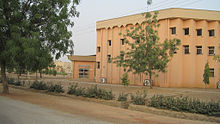
Universities
- The Bayero University Kano is the oldest university in the city. The seed of the university was the Ahmadu Bello College set up in 1962 by Isa Kaita. It was raised to the status of University College in 1975, with the right to award degrees on behalf of Ahmadu Bello University until 1980. It became a federal university in 1977, and remains an important institution of learning today.
- Sa'adatu Rimi University of Education Kano
- Skyline University Nigeria (SUN), founded in 2018.
- Yusuf Maitama Sule University, Kano (YUSMUK), founded in 2012.
Colleges
- Kano State Polytechnic was founded in 1975.
- Federal College of Education, Kano
- Aminu Kano College of Islamic Legal Studies, Kano
Transport


Kano houses a railway station with trains to Lagos routed through Kaduna, while Mallam Aminu Kano International Airport lies nearby. The city is supplied with water by the nearby Challawa Gorge Dam, which is being considered as a source of hydro power. Because Kano is north of the rail junction at Kaduna, it has equal access to the seaports at Lagos and Port Harcourt.
The airline Kabo Air had its head office in the city. Kano was also headquarters of Azman Airlines and is the headquarters city of Max Air and various independent travel agencies. After a hiatus of many years, the railway line from Kano to Lagos was rehabilitated by 2013. The train trip to Lagos takes 30 hours and costs the equivalent of US$12, only a quarter of the equivalent bus fare.
In 2014, a new double track, standard gauge line is under construction from Lagos.
In 2017, a 74-km, four-line light rail network was announced by the Kano State Ministry of Works, Housing & Transport; with a US$1.8 billion contract signed with China Railway Construction Corporation.
Two trans-African automobile routes pass through Kano:
From 2006 to 2015, backed by high oil prices, major highways, overhead bridges and other transportation infrastructure were built by the state government. The most notable of these are the Silver Jubilee flyover bridge at Kofar Nassarawa, the Kofar Kabuga underpass and various 6-lane highways in the city. In 2020, the Vice president of Nigeria Yemi Osibanjo was in Kano to commission the Alhassan Dantata flyover along Murtala Muhammad Way and Tijjani Hashim underpass way, Kofar Ruwa.

Notable people
- Sani Abacha, former Nigerian Head of State
- Lawan Musa Abdullahi, lawyer and politician
- Aliko Dangote, entrepreneur.
- Auwalu Abdullahi Rano, Businessman and entrepreneur
- Alhassan Dantata, businessman
- Abdullahi Umar Ganduje, current APC party chairman
- Aminu Kano, teacher, politician and reformer
- Rabiu Kwankwaso, politician, former Governor of Kano State, Senator in the Nigerian Senate and Minister of Defense
- Murtala Muhammed, former Head of State, Federal Republic of Nigeria.
- Abdul Samad Rabiu, entrepreneur
- Isyaku Rabiu, businessman
- Abubakar Rimi former Governor of Kano state.
- Sanusi Lamido Sanusi, banker
- Ibrahim Shekarau, politician, former Governor of Kano State, Minister of Education, and Nigerian Senate
- Abdullahi Aliyu Sumaila bureaucrat and politician.
- Alhassan Yusuf, footballer, currently plays for New England Revolution
See also
References
- "Kano 2024-25".
- "TelluBase—Nigeria Fact Sheet (Tellusant Public Service Series)" (PDF). Tellusant. Retrieved 2024-01-11.
- "Kano | state, Nigeria". Encyclopedia Britannica. Retrieved 2021-05-17.
- "Nigeria: cities with the largest population 2022". Statista. Retrieved 2023-06-20.
- "Kano | historical kingdom, Nigeria". Encyclopedia Britannica. Retrieved 2021-06-05.
- Newman, Paul, ed. (2022), "The Hausa Language", A History of the Hausa Language: Reconstruction and Pathways to the Present, Cambridge: Cambridge University Press, pp. 1–5, doi:10.1017/9781009128070.002, ISBN 978-1-009-12310-5, retrieved 2024-05-26
- Tour Nigeria (2022-03-12). "Kano State, The Centre of commerce". m.facebook.com. Retrieved 2024-05-26.
- Nast, Heidi J (2005). Concubines and Power: Five Hundred Years in a Northern Nigerian Palace. University of Minnesota Press. p. 60. ISBN 0-8166-4154-4.
- Adamu, Abdullaha (2010). Perspective on Kano (First ed.). Kano state: Tellettes and Consultanting Company Ltd. p. 200. ISBN 978-978-8092-53-7.
- Iliffe, John (2007). Africans: The History of a Continent. Cambridge University Press. p. 75. ISBN 978-0-521-86438-1.
- Isichei, Elizabeth (1997). A History of African Societies to 1870. Cambridge Universitas Press. p. 234. ISBN 0-521-45599-5.
- Okehie-Offoha, Marcellina; Matthew N. O. Sadiku (December 1995). Ethnic and Cultural Diversity in Nigeria. Africa World Press. p. 40. ISBN 978-0-86543-283-3.
- Britannica, Kano, britannica.com, USA, accessed on July 7, 2019
- "Kano". Britannica Online. Encyclopædia Britannica, Inc. 2 May 2024.
- ^ Ki-Zerbo, Joseph (1998). UNESCO General History of Africa, Vol. IV, Abridged Edition: Africa from the Twelfth to the Sixteenth Century. University of California Press. p. 107. ISBN 0-520-06699-5.
- Fisher, Humphrey J. (1978). "Leo Africanus and the Songhay Conquest of Hausaland". The International Journal of African Historical Studies. 11 (1): 86–112. doi:10.2307/217055. ISSN 0361-7882. JSTOR 217055.
- "Caravans Across the Desert: Marketplace". AFRICA: One Continent. Many Worlds. Natural History Museum of Los Angeles County Foundation. Archived from the original on January 2, 2005. Retrieved 2007-05-06.
- "50 Greatest Africans – Sarki Muhammad Rumfa & Emperor Semamun". When We Ruled. Every Generation Media. Retrieved 2007-05-05.
- Green, Toby (2020). A Fistful of Shells. UK: Penguin Books. p. 57.
- Nast, p. 61
- ^ Lovejoy, Paul (1983). Transformations in Slavery: A History of Slavery in Africa. Cambridge UK: Cambridge University Press. p. 195. ISBN 0-521-24369-6.
- ^ Milich, Lee (1997-07-17). "Food Security in Pre-Colonial Hausaland". College of Agriculture and Life Sciences. Retrieved 2007-10-26.
- ^ Meredith, Martin (2014). The Fortunes of Africa: A 5000 Year History of Wealth, Greed and Endeavour. New York: Public Affairs. p. 167. ISBN 978-1-61039-459-8.
- Stilwell, Sean (2000). "Power, Honour and Shame: The Ideology of Royal Slavery in the Sokoto Caliphate". Africa: Journal of the International African Institute. 70 (3). Edinburgh University Press: 394–421. doi:10.2307/1161067. JSTOR 1161067.
- Christelow, Allan (1987). "Property and Theft in Kano at the Dawn of the Groundnut Boom, 1912–1914". The International Journal of African Historical Studies. 20 (2). Boston University African Studies Center: 225–243. doi:10.2307/219841. JSTOR 219841.
- Dan-Asabe, Abdulkarim Umar (November 2000). "Biography of Select Kano Merchants, 1853–1955". FAIS Journal of Humanities. 1 (2). Archived from the original on October 9, 2007. Retrieved 2007-10-09.
- Ernest E. Uwazie; Isaac Olawale Albert; G. N. Uzoigwe (1999). "The Role of Communication in the Escalation of Ethnic and Religious Conflicts". Inter-Ethnic and Religious Conflict Resolution in Nigeria. Lexington Books. p. 20. ISBN 0-7391-0033-5.
- Uwazie et al., p. 73
- Gambari, Ibrahim (1992). "The Role of Religion in National Life: Reflections on Recent Experiences in Nigeria". In Hunwick, John Owen (ed.). Religion and National Integration in Africa: Islam, Christianity and Politics in the Sudan and Nigeria. Northwestern University Press. p. 90. ISBN 0-8101-1037-7.
- "Nigeria's Kano state celebrates Sharia". BBC News. 2000-06-21. Retrieved 2007-11-04.
- Obasanjo Assesses Riot Damage in Kano – 2001-10-16. Voice of America News.
- "Kano: Nigeria's ancient city-state". BBC online. BBC. 2004-05-20. Retrieved 2007-07-12.
- "Army patrols Kano after clashes". News.BBC.com. BBC News. 2007-11-21. Retrieved 2007-11-21.
- Karofi, Hassan A; Halima Musa (2007-11-21). "ANPP Sweeps Kano LG Polls". Daily Trust online. Retrieved 2007-11-21.
- Shuaibu, Ibrahim (2007-11-21). "Kano Death Toll Rises to 25". Thisday online. Leaders & Company. Archived from the original on 2007-12-01. Retrieved 2007-11-21.
- "Nigeria violence: Scores dead after Kano blasts". BBC News. 2012-01-21. Retrieved 2012-01-22.
- "Many Dead Following Bomb Blasts in Kano, Nigeria". The Global Herald. Archived from the original on 2013-07-21. Retrieved 2012-01-23.
- "The Intrigues And Politics Of SLS's Emergence As Kano Emir, As Presidency Plots To Sack Him, Kwankwaso". THE WILL. 10 June 2014. Retrieved 2020-07-03.
- Fawehinmi, Feyi (2016-05-02). "Guest Post 1: The Case AGAINST Sanusi Lamido Sanusi As Emir of Kano". Medium. Retrieved 2020-07-03.
- "How Lamido Sanusi escaped arrest after emerging Emir | Premium Times Nigeria". 2014-06-09. Retrieved 2020-08-05.
- Blueprint (2014-06-12). "Jonathan orders Sanusi's arrest, Kwankwaso says". Blueprint Newspapers Limited. Retrieved 2020-08-05.
- "Ganduje signs law creating new emirates in Kano". 2019-12-05. Retrieved 2020-07-23.
- "Kano elders ask Ganduje to repeal law creating four new emirates". Tribune Online. 2019-12-08. Retrieved 2020-07-23.
- "Govnors dey tamper traditional kingdoms?". BBC News Pidgin. Retrieved 2021-06-05.
- "New emirates: You can't usurp powers of kingmakers, court tells Ganduje". TheCable. 2019-12-10. Retrieved 2020-07-23.
- "ANALYSIS: How Ganduje's 'fight' with Emir Sanusi alters Kano history". Premium Times Nigeria. 12 May 2019. Retrieved 23 January 2020.
- Bukar, Muhammad (9 March 2020). "BREAKING: Emir of Kano Muhammadu Sanusi dethroned". Daily Post Nigeria. Retrieved 9 March 2020.
- "Nigeria's Lamido Sanusi is dethroned for a second time". The Africa Report.com. 2020-03-09. Retrieved 2021-06-05.
- "Nigerian High Court Orders Release of Detained Former Islamic Ruler". Council on Foreign Relations. Retrieved 2021-06-05.
- "Sanusi arrested, exiled to Nassarawa". Latest Nigeria News, Nigerian Newspapers, Politics. 2020-03-09. Retrieved 2021-06-05.
- "World Meteorological Organization Climate Normals for 1991-2020 — Kano". National Oceanic and Atmospheric Administration. Retrieved January 7, 2024.
- "Kano Climate Normals 1961–1990". National Oceanic and Atmospheric Administration. Retrieved 7 July 2016.
- "Metro Kano (Nigeria): Local Government Areas - Population Statistics, Charts and Map". www.citypopulation.de. Retrieved 2024-02-05.
- Barau, A.S. (2007) The Great Attractions of Kano.
- M. G. Smith (1997). Government In Kano, 1350-1950. Avalon Publishing. p. 257. ISBN 9780813332703.
- "Nigerian city of Kano plans IT park". Panapress. Afriquenligne. 2007-11-04. Archived from the original on 2008-02-11. Retrieved 2007-11-04.
- ^ "Emir of Kano, Sanusi II rides through Kano during Durbar festival". Vanguard News. 2016-07-07. Retrieved 2023-06-05.
- "Emir of Kano, Sanusi II rides through Kano during Durbar festival". Vanguard News. 2016-07-07. Retrieved 2023-12-11.
- "Emir of Kano, Sanusi II rides through Kano during Durbar festival". Vanguard News. 2016-07-07. Retrieved 2021-06-05.
- "Nigeria: Kano cancels famous durbar horse festival". BBC News. 2012-08-15. Retrieved 2021-06-05.
- Umar, Gali Kabir; Yusuf, Danjuma Abdu; Ahmed, Abubakar; Usman, Abdullahi M. (2019-09-01). "The practice of Hausa traditional architecture: Towards conservation and restoration of spatial morphology and techniques". Scientific African. 5: e00142. Bibcode:2019SciAf...500142U. doi:10.1016/j.sciaf.2019.e00142. ISSN 2468-2276.
- "A fading future for Nigeria's indigo dyers". BBC News. 2014-02-03. Retrieved 2021-06-05.
- J. Gordon Melton, Martin Baumann, Religions of the World: A Comprehensive Encyclopedia of Beliefs and Practices, ABC-CLIO, USA, 2010, p. 2107
- "The Rt Revd Zakka Nyam on World Anglican Clerical Directory". World Anglican Clerical Directory. Retrieved 2021-06-05.
- "Diocese of Kano, Nigeria". GCatholic. Retrieved 2021-06-05.
- "When Emir of Kano, Baptists hosted CAN president". Tribune Online. 2019-11-24. Retrieved 2021-06-05.
- "The Presbyterian Church | Kano". AfricaBizInfo. Retrieved 2021-06-05.
- "Ancient Kano City Walls and Associated Sites". UNESCO World Heritage Centre. Retrieved 2021-06-05.
- "History, Facts and Figures". BUK.edu.ng. Bayero University Kano. Retrieved 2024-09-01.
- "Sa'adatu Rimi College of Education Kano". Sa'adatu Rimi College of Education Kano.
- "ABOUT SKYLINE UNIVERSITY NIGERIA". sun.edu.ng. Archived from the original on June 11, 2020. Retrieved 2020-05-19.
- "Federal College of Education, Kano, Kano State | Official Portal". fcekano.edu.ng.
- "FG to open Kano, new MM International Airports for use in March". Nairametrics. 2021-03-06. Retrieved 2021-06-05.
- PROF. ABDU SALIHI, FNSE (May 11–12, 2009). "Hydropower Development at Tiga and Challawa Gorge Dams, Kano State, Nigeria" (PDF). International Network on Small Hydro Power (IN-SHP). Archived from the original (PDF) on 2011-07-26. Retrieved 2009-10-02.
- "Contact Us." Kabo Air. Retrieved on 27 November 2010. "HEAD OFFICE 67/73 Ashton Rd P.O.Box 1850 Kano State Nigeria"
- "Trains in Nigeria: A slow but steady new chug," The Economist
- "ZTE COMMUNICATIONS FOR NIGERIA'S RAILWAY". Railways Africa. Archived from the original on 9 June 2014.
- "Kano light rail contract signed". Metro Report. 17 February 2017. Retrieved 22 July 2019.
- "Nigeria to build a light rail system in Kano". Railway Pro. 2 September 2016. Retrieved 22 July 2019.
- "Osinbajo arrives Kano, commissions Dantata flyover". 2020-01-13. Retrieved 2021-06-05.
- "Remembering Sani Abacha". Latest Nigeria News, Nigerian Newspapers, Politics. 2021-06-13. Retrieved 2021-06-28.
- "Buhari, Biafra And Twitter, By Ozodinukwe Okenwa". Sahara Reporters. 2021-06-05. Retrieved 2021-06-28.
- Ibrahim, Hamza (2021-01-22). "Nigerian appeals court throws out blasphemy convictions that caused outcry". Reuters. Retrieved 2021-06-28.
- "Who Is Aliko Dangote? – History and Biography Of The Richest Man In Nigeria". BuzzNigeria - Famous People, Celebrity Bios, Updates and Trendy News. 2021-06-01. Retrieved 2021-06-28.
- "Dangote vs BUA: Borrowing from Ganduje's initiative". The Guardian Nigeria News - Nigeria and World News. 2021-04-18. Retrieved 2021-06-28.
- ^ "Ganduje reconciles Dangote, BUA". Tribune Online. 2021-04-16. Retrieved 2021-06-28.
- Ero, Adekunbi; Perishable (14 February 2021). "The Real Reasons Sanusi was Deposed as Emir of Kano – Gov. Ganduje - TELL". tell.ng. Retrieved 2021-06-28.
- "KANO: Sanusi Absent As New Kano Emirs Attend Ganduje's Inauguration". The Whistler Nigeria. 2019-05-29. Retrieved 2021-06-28.
- Akyeampong, Emmanuel Kwaku; Gates, Henry Louis (2012). Dictionary of African Biography. New York: Oxford University Press, Inc. p. 289. ISBN 978-0-19-538207-5.
- Dudley, B. J. (2012). Parties and Politics in Northern Nigeria. Abingdon, Oxfordshire: Routledge. p. 107. ISBN 978-1-136-96182-3.
- Awa, Eme O. (1964). Federal Government in Nigeria. Berkeley and Los Angeles: University of California Press. p. 99.
- "Ex-PDP govs move to 'rescue' Nigeria from insecurity". Tribune Online. 2021-06-18. Retrieved 2021-06-28.
- "Breaking: Kwankwanso, 10 Kano state lawmakers dump APC for PDP". Vanguard News. 2017-03-14. Retrieved 2021-06-28.
- "Kano mysterious deaths: Kwankwaso writes Buhari, wants probe into cause of deaths". Vanguard News. 2020-04-28. Retrieved 2021-06-28.
- "Murtala Muhammad, 45 Years After!". THISDAYLIVE. 2021-02-21. Retrieved 2021-06-28.
- "ICYMI: Late Murtala Muhammed's son, two ex-guber candidates, others defect to APC in Kano". Tribune Online. 2021-06-13. Retrieved 2021-06-28.
- ^ "Glad Tidings! Billionaire Industrialist Abdul Samad Rabiu Is 60". THISDAYLIVE. 2020-08-09. Retrieved 2021-06-28.
- "Abdulsamad Rabiu: Exploring the journey of Nigeria´s silent billionaire @ 60". Nairametrics. 2020-08-04. Retrieved 2021-06-28.
- "Remembering Abubakar Rimi". THISDAYLIVE. 2019-04-05. Retrieved 2021-06-28.
- "Rimi's giant footprints: Tribute to the last great leader". Vanguard News. 2018-04-13. Retrieved 2021-06-28.
- "Making Nigeria Work According To Sanusi". Vanguard News. 2021-06-19. Retrieved 2021-06-28.
- "Broadening Perspectives on Nigeria with Sanusi's New Book". THISDAYLIVE. 2021-06-18. Retrieved 2021-06-28.
- "Former Kano Emir, Lamido Sanusi named new leader of Islamic sect". 2021-03-13. Retrieved 2021-06-28.
- "2023 Elections: Ibrahim Shekarau preaches balance, common sense". Vanguard News. 2021-01-03. Retrieved 2021-06-28.
- "Newly Elected Senators [FULL LIST]". Independent Newspaper Nigeria. March 2019. Retrieved 2021-06-28.
- "Sweden Cup triumph doubly special celebrates Alhassan Yusuf". Score Nigeria. 2020-07-31. Archived from the original on August 14, 2020. Retrieved 2021-06-28.
- Colman, Jonty (2020-06-12). "Who is Alhassan Yusuf? Teenager profiled amid United and Barcelona links". YorkshireLive. Retrieved 2021-06-28.
- "Goteborg Nigerian Midfielder Yusuf Linked With Wolves, Sheffield". Complete Sports. 2020-06-13. Retrieved 2021-06-28.
Further reading
See also: Bibliography of the history of Kano- Maconachie, Roy (2007). Urban Growth and Land Degradation in Developing Cities: Change and Challenges in Kano, Nigeria. King's SOAS Studies in Development Geography. Ashgate Publishing. ISBN 978-0-7546-4828-4.
- Barau, Aliyu Salisu (2007). The Great Attractions of Kano. Research and Documentation publications. Research and Documentation Directorate, Government House Kano. ISBN 978-978-8109-33-4.
External links
- "Kano" . New International Encyclopedia. 1905.